One of my all-time favorite pieces of paleo-art is Douglas Henderson’s 1989 painting Tarbosaurus and Saurolophus which depicts a red-headed Tarbosaurus pursuing a herd of Saurolophus crossing a river. Like all the best paleo-art this piece serves as a time machine and as a kid I would stare at and study it. I would put myself in that time and place and imagine the various scenarios that may have played out between the characters depicted in the painting. So enamored with the piece am I that a poster of it adorns my daughter’s bedroom, in the hopes that it might transport her into deep time the same way it did me.
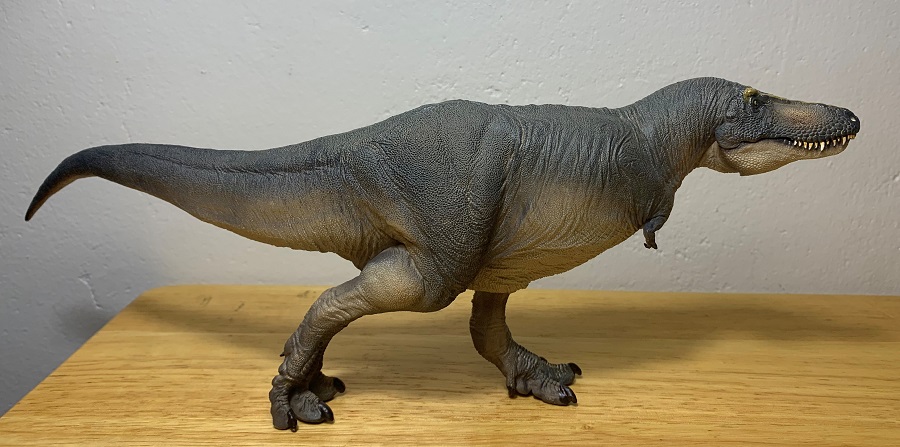
Because of that painting’s power on my psyche, I also have a soft spot for the animals depicted within it. As a result, I’ve long desired for some good figures of Tarbosaurus and Saurolophus. With Tarbosaurus a few options have come along over the years. Kaiyodo has a fantastic figurine of one feeding on a Saurolophus corpse. Part of Kaiyodo’s Dinotales line, it is quite small and no longer in production. CollectA has a Tarbosaurus too, but the less said about that one the better, it comes from their early hit-and-miss era. The Favorite Tarbosaurus is rather nice but as a museum exclusive, also rare and expensive. The year 2020 also saw the release of a Tarbosaurus from Mattel but that one is a Jurassic World action figure that doesn’t scratch the itch for a scientifically accurate and lifelike model. That brings us to Chuanzi, PNSO’s Tarbosaurus released in 2021, the only satisfactory option for a nice scale model of Tarbosaurus and the subject of today’s review.
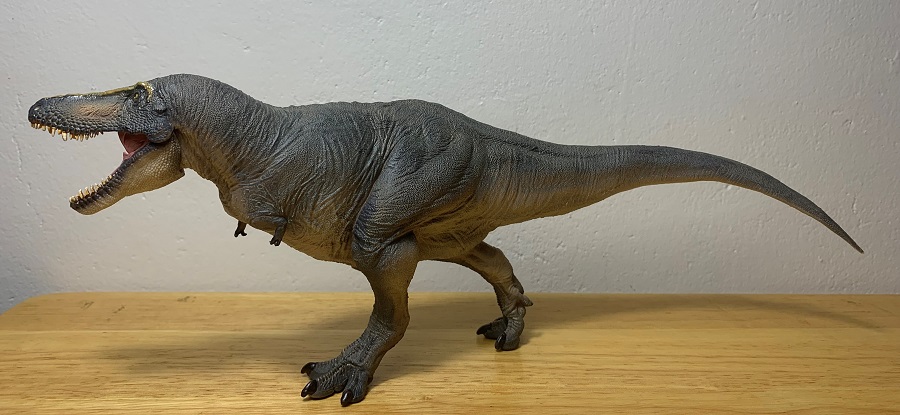
Chuanzi measures 12.5” (37.75 cm) long and stands 4” (10.16 cm) tall to the top of his head. Tarbosaurus was smaller and less robust than Tyrannosaurus, though not by much. Estimates put Tarbosaurus at 33-39’ (10-12 meters) in length and that puts Chuanzi at 1/31-1/37 in scale. It’s important to point out that although Tarbosaurus is far less popular than Tyrannosaurus it would have been the largest tyrannosaurid in Asia and it is so like Tyrannosaurus that some paleontologists have argued that it should be in the same genus, changing Tarbosaurus bataar to Tyrannosaurus bataar. If these animals existed in the modern day they would almost certainly belong to the same genus, just as lions, tigers, leopards, snow leopards, and jaguars all belong to the Panthera genus.
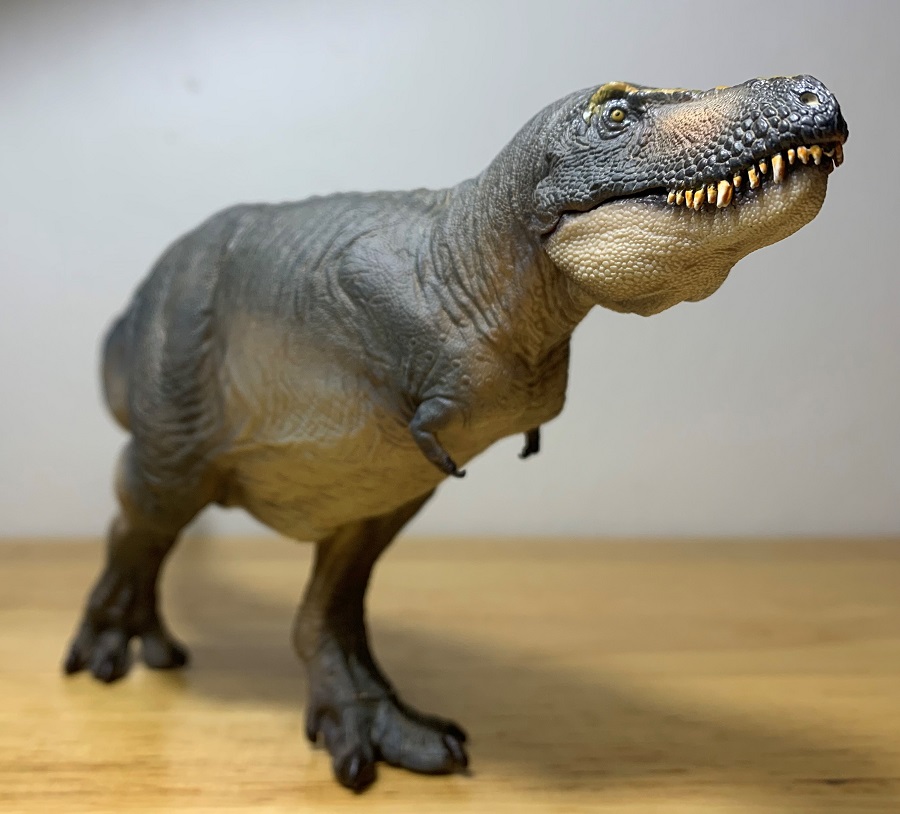
Chuanzi is depicted striding forward with the left leg forward of the right, and the right pushing off the ground. The head is lifted high and looking rightward and the tail curves towards the left. He appears confident in his supremacy over his contemporaries and there’s no doubt about it, he’s the ruler of his ecosystem. I find Chuanzi’s posture overall more pleasing than the tilted forward posture of Wilson or Yinqi, the Yutyrannus.
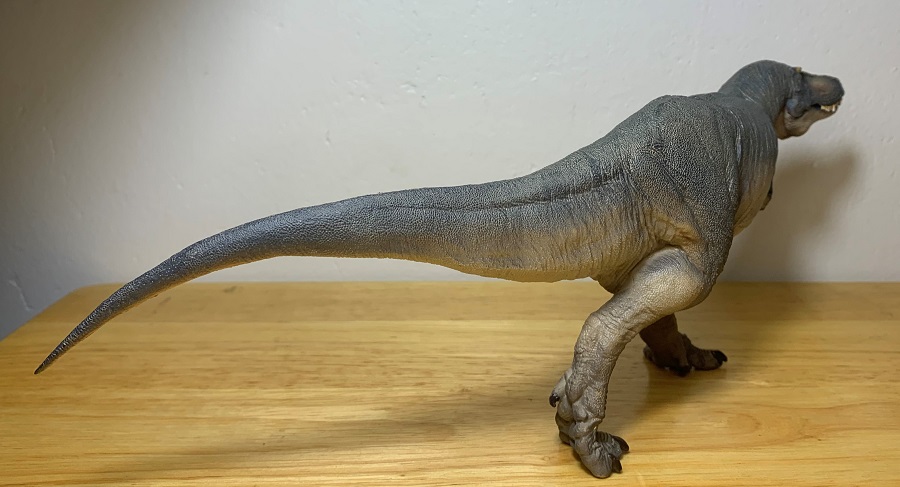
Although Chuanzi comes with a support rod I find the figure quite stable with no real need for additional support for the time being. The stability of the figure is aided by what some might consider oversized feet but to me the feet just appear well padded, as they should on such a large animal. Like other PNSO theropods the mouth is nicely articulated and PNSO has really nailed the articulation feature of these figures.

Perhaps the most immediately noticeable feature of this Tarbosaurus is just how chunky, deep chested, and muscular it is. The proportions of this figure have led to much discussion online about the figure’s accuracy and aesthetic appeal. It’s true, the massive thighs and deep chest don’t appear particularly accurate for Tarbosaurus, but it is difficult for me to take this figure to task when these features also make it look so powerful and formidable. We can just interpret Chuanzi as a particularly well fed, in his prime, individual.
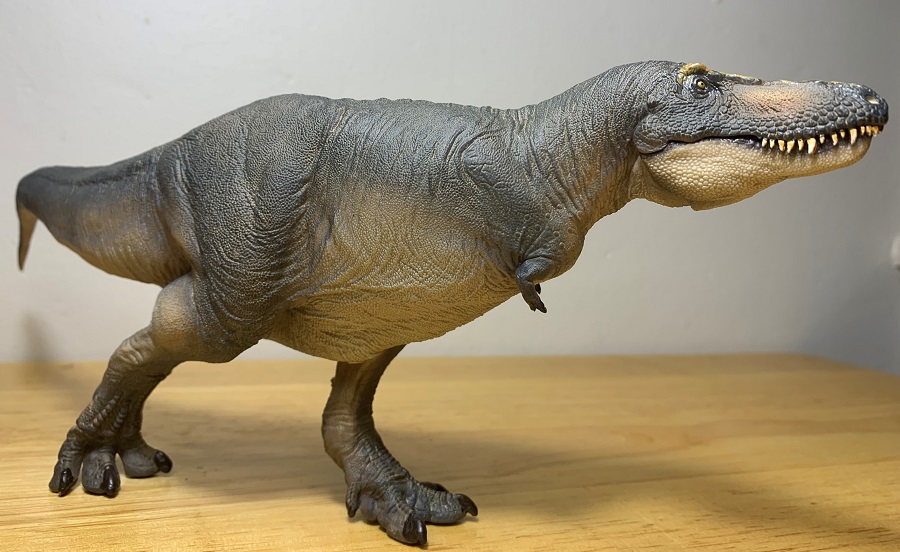
Also noticeable are the ways in which Chuanzi differs from Wilson the Tyrannosaurus and other, earlier PNSO theropods. I don’t have a Wilson to directly compare this figure to but Chuanzi fixes many of the issues I had with that figure. Although still lipless the teeth on Chuanzi are smaller than Wilson’s and appear more firmly rooted into his jaws. The size of the scales has also been significantly scaled back. The detail is still there, it’s just finer and thus, more accurate.
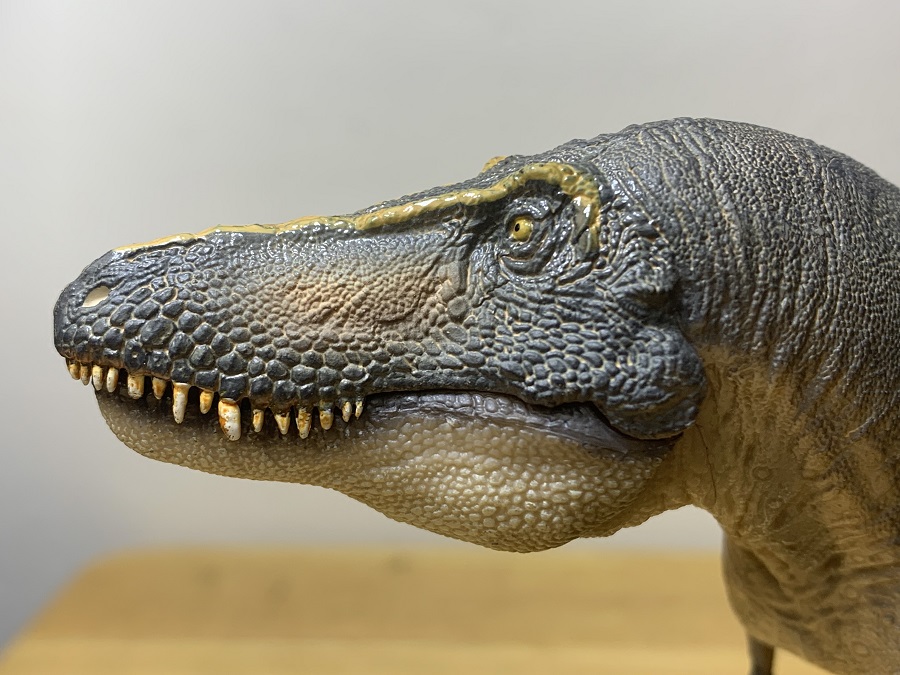
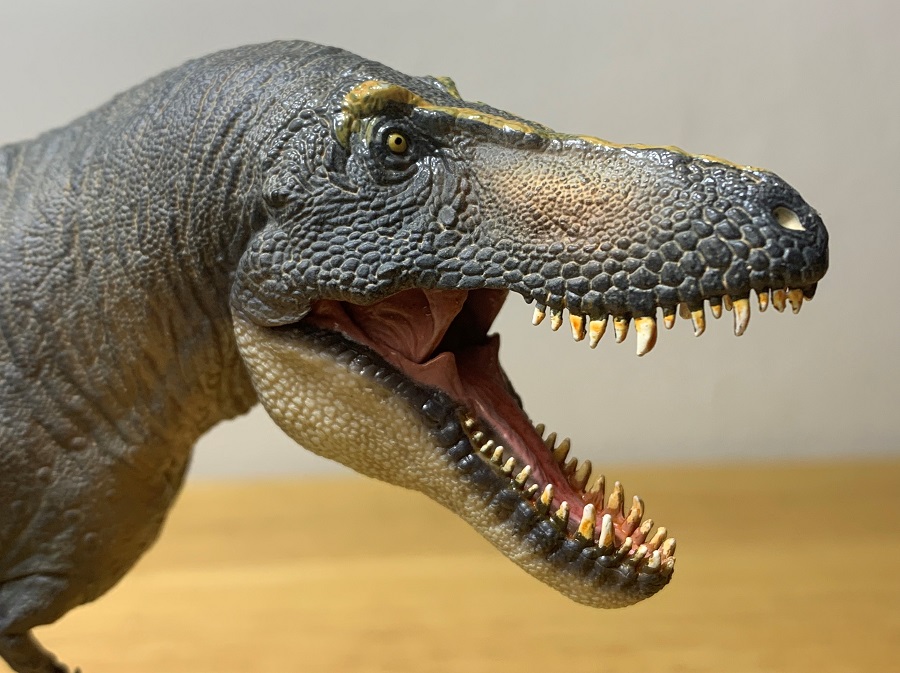
Looking at the fine details we see large irregularly shaped scales around the tip of the snout and along the lips, like Wilson. These are the largest scales on the entire figure, aside from the scutes running down the toes. Smaller scales are sculpted on the antorbital fenestra and lower jaw, although those clustered around the back of the jaw are a bit larger than those elsewhere. The teeth are of varying lengths, and the inside of the mouth is nicely sculpted with sockets for the lower teeth and visible nasal passages on the roof of the mouth.


A bony Y-shaped crest is sculpted running down over each eye and down to the tip of the snout. The crest is painted yellow with a shiny finish, giving it a keratinous appearance. The head sculpt is overall shallower and narrower than it would be on a T. rex, and when viewed from above has a more gradual wedge shape, back to front, than the dramatic T-shaped skull of T. rex.
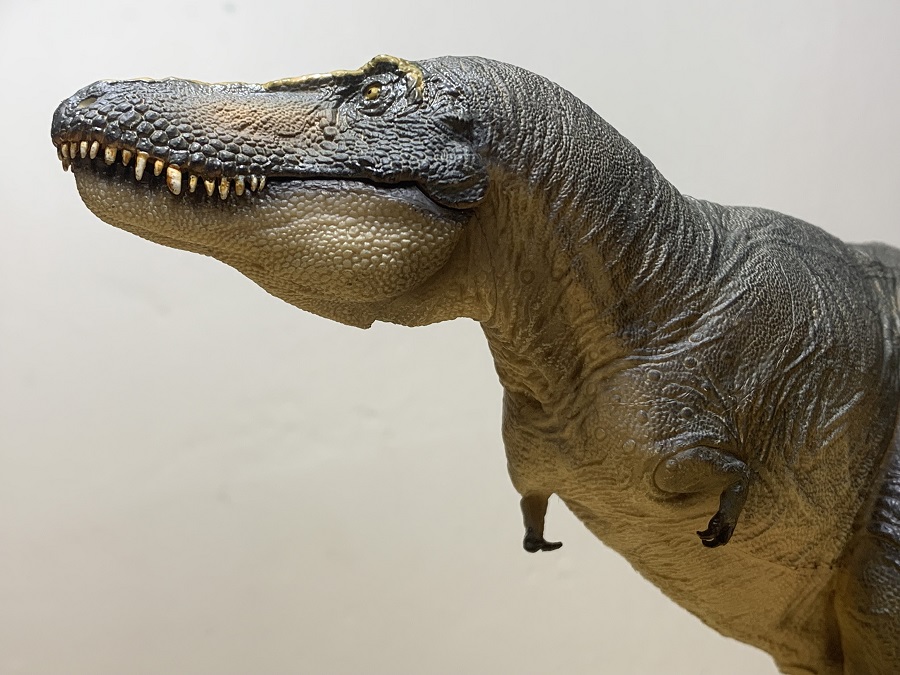
The neck and torso are appropriately robust and powerful looking and although Chuanzi is deep chested when viewed from above he is more laterally compressed than a Tyrannosaurus rex would be. The arms are miniscule with the upper arms so muscular and thick that they almost appear to be part of the torso itself. This is accurate as Tarbosaurus had arms that were even smaller than those on Tyrannosaurus rex. The arms are nicely tucked in with the claws curving towards the chest. The scapula and pelvis are slightly visible under the skin, despite the model’s chunky build.
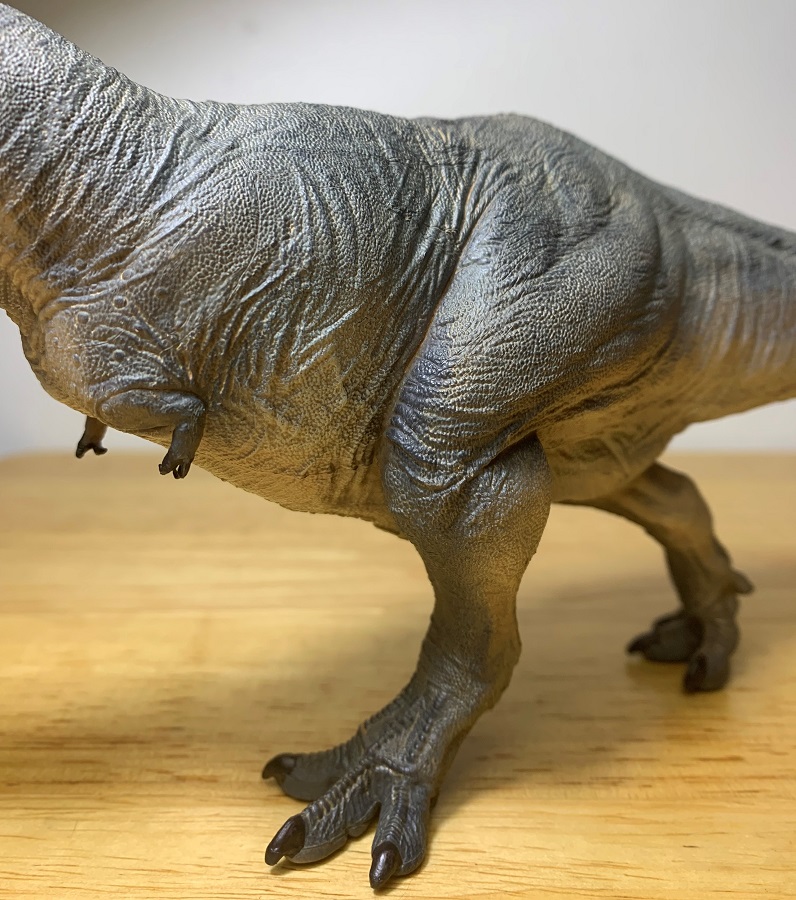
The entire figure is covered in small pebbly scales that match closely with known skin impressions for Tarbosaurus. Some larger, circular scales are sculpted around and between the arms and under the neck. Skin folds and veins are evident in the appropriate places, they stretch apart and bunch together on the various portions of the figure’s body in a realistic way. Regardless of some of their design choices PNSO always excels at sculpting lifelike movement into their figures.

As stated before, the thighs on this figure are rather thick, as is the base of the tail. I find this refreshing in a theropod toy as this portion of the body would have been well muscled, too many theropod figures make the tails too thin at the base, ignoring the massive caudofemoralis muscles we know these animals needed for balance and bipedal movement. The calves too are well muscled and bulge outwards, further accentuating the power of this animal. The feet are thick and padded, another often neglected feature that I like to see on my theropod figures.
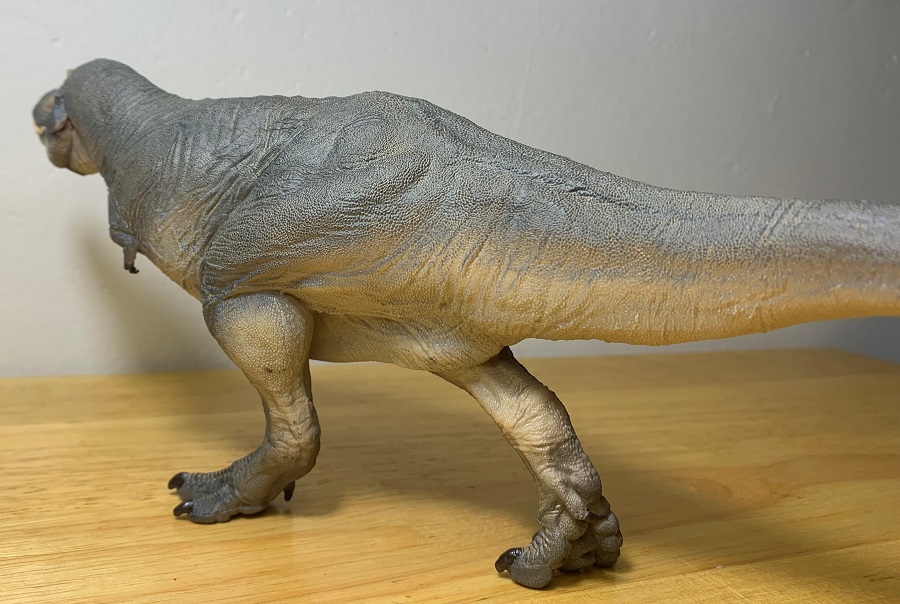
Moving on to the paintjob this toy is rather simple, being mostly gray with a pinkish underside and brown wash. There are no stripes, spots, or patterns of any kind, just a gradual blending of a few drab colors. Although gray dinosaurs are somewhat of a trope, I find it refreshing here, at least for PNSO. So many of PNSO’s dinosaurs have virtually identical colors and patterns. The simplicity here works, and really helps bring out the fine details in much the same way the monochrome Invicta figures of the past did. Sometimes, less is more.

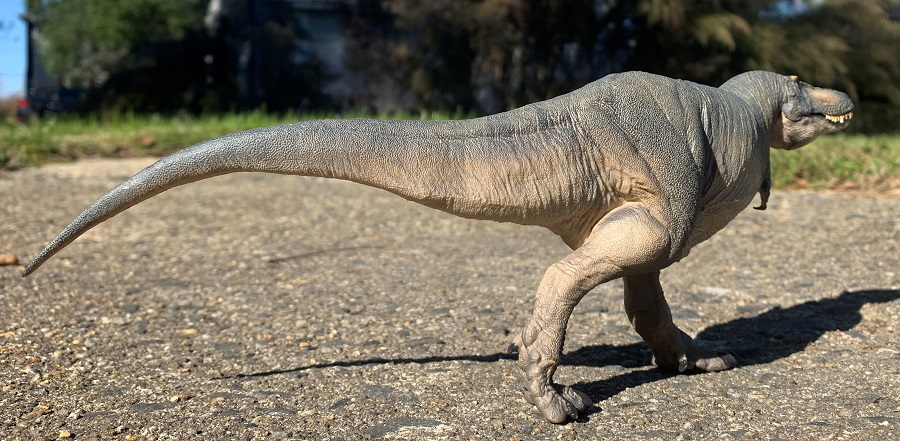
The toe and fingernails are all painted in shiny black, and the teeth are white with some brown staining around them, the tongue and inside of the mouth are pink and red. The eyes are yellow with black pupils and although the figure possesses forward facing eyes they don’t exactly line up on my copy, or on a few others I’ve seen online.
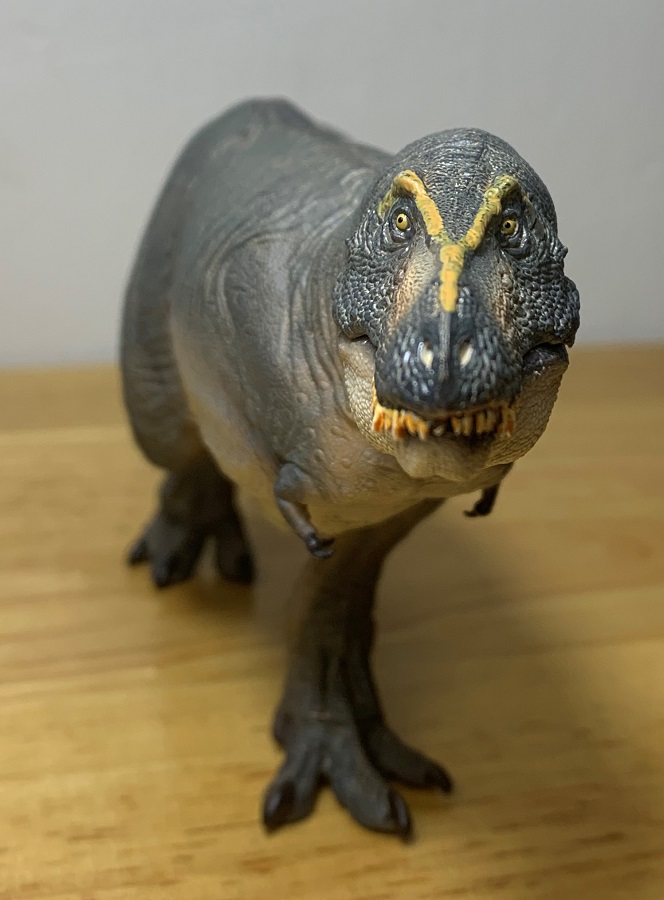
Chuanzi is not only my favorite PNSO theropod but also one of my favorite PNSO figures in general. It fixes many of the issues I had with their previous theropods and finally brings us a long overdue Tarbosaurus, with an imposing appearance, shelf presence, and lifelike quality that should please even the most scrupulous collector. I personally have no real complaints with it, although I would have preferred lips over exposed teeth. Others may dislike his chubby, muscular build, or mundane coloration, but since I like those features, I consider this figure damn near perfect.
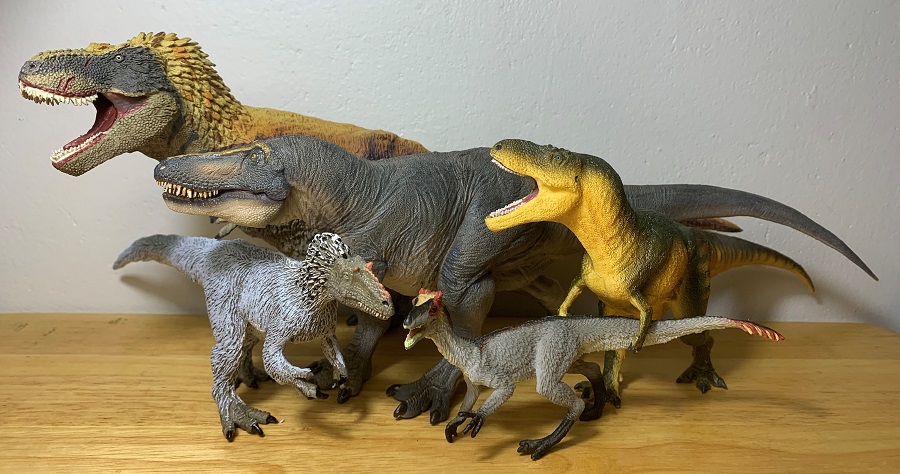

Now we just need a Saurolophus to pair with Chuanzi, so I can finally recreate the scene from that Doug Henderson painting I’ve been staring at for the last 30 years. I feel confident that we’ll someday get one from PNSO and considering how great their track record is on ornithopods, I eagerly await it. The PNSO Tarbosaurus can be found on various online shops and retails for about $40.
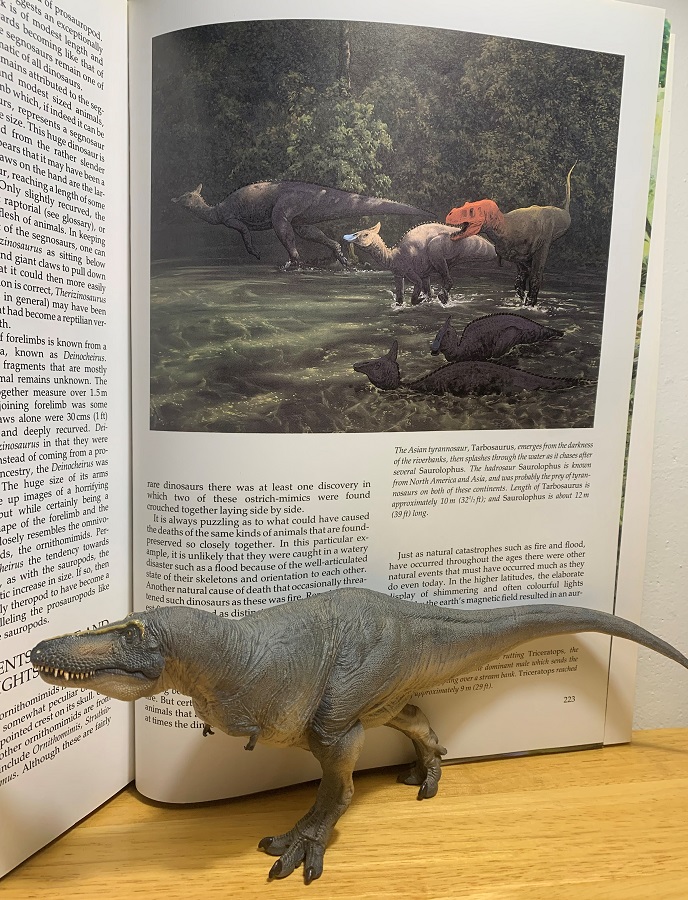
Disclaimer: links to Ebay and Amazon on the DinoToyBlog are affiliate links, so we make a small commission if you use them. Thanks for supporting us!





It is interesting that this figure does not have stability problems as you say. The figure is exceptional and above all what I like the most about PNSO theropods is how highly scientific they are with updates. This tarbosaurus is highly muscular according to scientific information that was deduced from the mummified remains of DaKota.
Monochrome paint is great and gives it a more natural look. Undoubtedly the tarbosaurus memor together with Favorite’s best done to date, this being much more detailed in teeth or claws to give two example.
It is a beautiful and detailed article.
I apologize, maybe I misunderstood, but calling the work Favorite is at least somewhat better than the discussed PNSO Tarbosaurus is strange. There is a cosmic abyss between them. And not in favor of Favorite.
Very fond of this toy too, and that particular painting as well. Although if memory serves me right, that book is the one by Stephen and Sylvie Czerkas, whom I’m not a fan of. They’re a prime example of talented paleoartists who fell short of being talented paleontologists. They’re the ones responsible for the “Archaeoraptor” debacle.
Yes, the book is written by Stephen and Sylvie Czerkas. Their fall from grace brings David Peters to mind. I adore this book though, mostly for its pictures, many of which are by Douglas Henderson.
Yes, I’d definitely put them in the same category as Peters, although certainly not as deranged.